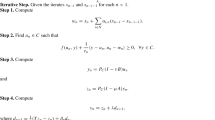Abstract
It is commonly stated that the Poisson’s ratio associated with bond-based peridynamics is \(\tfrac{1}{4}\) for three-dimensional isotropic elasticity. This manuscript critically revisits this statement from a variational perspective for both two-dimensional and three-dimensional problems. To do so, a purely geometrical description of Poisson’s ratio is considered. Unlike the commonly established treatment of the problem, the Poisson’s ratio here is calculated via minimizing the internal energy density, rather than quantifying it and comparing it to its counterpart in classical linear elasticity. The advantage of the proposed approach is threefold. Firstly, elements of Cauchy linear elasticity such as “strain”, “stress” and “elastic parameters” are entirely absent throughout the derivations here. This is particularly important since peridynamics is a non-local formulation, and therefore, using local notions such as “strain” and “stress” implies locality and is misleading. Secondly, unbound by linear elasticity, the proposed approach unlocks the limitation of the analysis to small deformations. Hence, it can be immediately applied to large deformations, resulting in a nonlinear Poisson’s ratio that is no longer constant. Thirdly, the two-dimensional analysis here is purely two-dimensional, corresponding to a two-dimensional manifold in a three-dimensional space. That is, the two-dimensional formulation is neither plane stress nor plane strain that are rather degenerate three-dimensional cases. This contribution introduces the notion of nonlinear Poisson’s ratio in peridynamics for the first time and proves that the nonlinear Poisson’s ratio at the reference configuration coincides with \(\tfrac{1}{4}\) for three-dimensional and \(\tfrac{1}{3}\) for two-dimensional problems.






Similar content being viewed by others
References
Silling S (2000) Reformulation of elasticity theory for discontinuities and long-range forces. J Mech Phys Solids 48(1):175–209
Dell’Isola F, Andreaus U, Placidi L (2015) At the origins and in the vanguard of peridynamics, non-local and higher-gradient continuum mechanics: An underestimated and still topical contribution of Gabrio Piola. Math Mech Solids 20(8):887–928
Madenci E, Oterkus E (2014) Peridynamic theory and its applications, Springer
Javili A, Morasata R, Oterkus E, Oterkus S (2019) Peridynamics Review. Math Mech Solids 24:3714–3739
Silling SA, Epton M, Weckner O, Xu J, Askari E (2007) Peridynamic states and constitutive modeling. J Elast 88(2):151–184
Silling SA, Lehoucq RB (2010) Peridynamic theory of solid mechanics. Adv Appl Mech 44:73–168
Javili A, McBride AT, Steinmann P (2019) Continuum-kinematics-inspired peridynamics. Mechanical problems. J Mech Phys Solids 131:125–146
Gerstle W, Sau N, Silling S (2005) Peridynamic modeling of plain and reinforced concrete structures, In: 18th international conference on structural mechanics in reactor technology (SMiRT 18) 54–68
Trageser J, Seleson P (2020) Bond-based peridynamics: a tale of two poisson ratios. Journal of Peridynamics and Nonlocal Modeling 2:278–288
Beatty MF, Stalnaker DO (1986) The poisson function of finite elasticity. Journal of Applied Mechanics, Transactions ASME 53(4):807–813
Mihai LA, Budday S, Holzapfel GA, Kuhl E, Goriely A (2017) A family of hyperelastic models for human brain tissue. J Mech Phys Solids 106:60–79
Bakiler AD, Javili A (2020) Bifurcation behavior of compressible elastic half-space under plane deformations. Int J Non-Linear Mech 126
Acknowledgements
The authors gratefully acknowledge the support provided by the Scientific and Technological Research Council of Turkey (TÜBITAK) Career Development Program, grant number 218M700.
Author information
Authors and Affiliations
Corresponding author
Ethics declarations
Conflicts of Interest
On behalf of all authors, the corresponding author states that there is no conflict of interest.
Additional information
Publisher’s Note
Springer Nature remains neutral with regard to jurisdictional claims in published maps and institutional affiliations.
Linearization Procedure
Linearization Procedure
The purpose of this Appendix is to show how the linearization of
furnishes
In doing so, we begin with the fact that
for which, the linearization yields
At the reference configuration, the first term reduces to unity as
Next, the derivative of \({\xi {}^{^{|}} }/{\Xi {}^{^{|}} }\) with respect to \(\boldsymbol {F}\) is evaluated as
where \(\boldsymbol {i}\) is the identity tensor. Thus,
This expression, evaluated at \(\boldsymbol {F} = \boldsymbol {I}\) returns
Finally, plugging this and Eq. (31) in the initial expression (30) yields
or simply
Rights and permissions
About this article
Cite this article
Ekiz, E., Javili, A. The Variational Explanation of Poisson’s Ratio in Bond-Based Peridynamics and Extension to Nonlinear Poisson’s Ratio. J Peridyn Nonlocal Model 5, 121–132 (2023). https://doi.org/10.1007/s42102-021-00068-9
Received:
Accepted:
Published:
Issue Date:
DOI: https://doi.org/10.1007/s42102-021-00068-9




